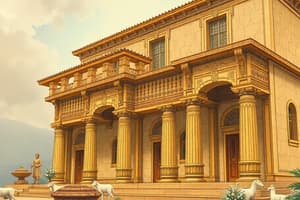Podcast
Questions and Answers
Which island was the largest known Minoan center?
Which island was the largest known Minoan center?
- Santorini
- Thera
- Crete (correct)
- Akrotiri
What is the term used to describe the undeciphered system of writing used by the Minoans?
What is the term used to describe the undeciphered system of writing used by the Minoans?
- Hieroglyphics
- Cuneiform
- Linear B
- Linear A (correct)
What caused the collapse of Minoan civilization around 1200 B.C.?
What caused the collapse of Minoan civilization around 1200 B.C.?
- Internal dissension
- External invaders
- Unknown (correct)
- Natural disaster
Which two cultures dominated the Greek and Aegean world before the classical Greek culture?
Which two cultures dominated the Greek and Aegean world before the classical Greek culture?
What is the possible religious significance of the bull imagery found in Minoan art?
What is the possible religious significance of the bull imagery found in Minoan art?
Who was King Minos of Crete and what myth is associated with him?
Who was King Minos of Crete and what myth is associated with him?
Which animal was featured in Mycenaean art?
Which animal was featured in Mycenaean art?
What evidence has provided the best information about Mycenaean civilization?
What evidence has provided the best information about Mycenaean civilization?
What role did geography play in the development of Greek city-states?
What role did geography play in the development of Greek city-states?
What language was used in the Mycenaean civilization?
What language was used in the Mycenaean civilization?
Flashcards are hidden until you start studying
Study Notes
Minoan and Mycenaean Cultures in Early Greece
- The Minoans were an island-based culture with a strong naval and trading empire, known for their bull imagery.
- The Mycenaeans were a collection of city-states scattered across the Peloponnese, known for their imposing architecture and battle scenes in their art.
- Before 750 B.C., there was limited knowledge of Greek history, with information primarily coming from myths.
- Sir Arthur Evans discovered the remains of a palace in Knossos, Crete, with depictions of bulls and a labyrinth, providing evidence for the existence of the Minoan civilization.
- The Minoans built large urban centers on the island of Crete and spread to other islands in the Aegean.
- Minoan palace structures had interconnected rooms clustered around a central courtyard, suggesting a peaceful society or a powerful navy that didn't require city walls.
- The Minoans were accomplished sailors and engaged in trade, as shown by nautical scenes in their frescoes.
- The bull was a significant symbolic animal to the Minoans, depicted in frescoes and sculptures, but its exact religious and cultural meaning remains unknown.
- The Minoans had a system of writing called Linear A, but it remains undeciphered.
- The Minoan civilization collapsed around 1200 B.C., possibly due to natural disasters such as earthquakes and a cataclysmic volcanic eruption on Thera.
- The Mycenaean civilization comprised small, independent kingdoms, with Mycenae as the largest city.
- Mycenaean cities were heavily fortified, focused on military concerns, and featured art depicting battle scenes and lions.
Studying That Suits You
Use AI to generate personalized quizzes and flashcards to suit your learning preferences.




